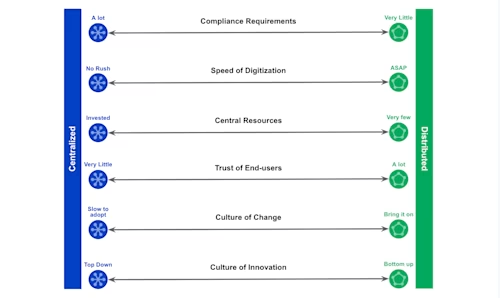
Choosing the Right Center of Excellence Model for Your Business
A Center of Excellence (CoE) is a group of experts in an organization who establish implementation standards and drive enterprise-wide success with technology.

This blog was contributed by Roshel Van Der Grinten, Senior Manager, Professional Services; and Dea Allgood, Principal Customer Success Architect.
A center of excellence (CoE) is a group of experts in an organization who establish implementation standards and drive enterprise-wide success with technology. You can implement a CoE in your organization in several different ways. The key is to strike the right balance between how much innovation you want to allow with your end users versus how much control you need to maintain over business processes.
Let’s explore two common CoE models rolled out by Docusign customers to help you evaluate which approach fits your organization best.
Two operating models for implementing a center of excellence
Many organizations choose between a centralized CoE, which provides more control over business processes, or a distributed CoE, which allows end users more flexibility. You may find, as most organizations do, that your ideal structure will fall somewhere in between these two models.
Centralized model
Companies tend to implement centralized models as part of a company-wide strategy to launch a tool for digital transformation, going paperless or streamlining business processes. Not surprisingly, these implementations are typically top-down initiatives with strong executive sponsorship. The IT organization will ideally interact with every business unit company-wide. The goal is to build once and reuse frequently for new use cases with the most efficient rollout possible.
In a centralized CoE, a central team manages most eSignature activity with limited involvement from business units. The centralized model revolves around:
Achieving a high-quality implementation driven by highly skilled technicians
Adhering to security and compliance protocols
Establishing formal change control processes
Working as efficiently as possible with no redundant efforts
For these reasons, the centralized model is popular among organizations in regulated industries, like financial services and insurance companies.
Distributed model
Organizations tend to implement distributed models when they want to encourage innovation. The distributed model often allows organizations to go live with eSignature more quickly than the centralized model. This model works well in bottom-up initiatives in organizations that have scarce central resources. By putting power in the hands of individual business units, companies can minimize roadblocks on the way to going live.
In a distributed CoE, the central team has minimal involvement in the eSignature implementation. Instead, individual business units own most of the rollout and management of eSignature. The distributed model revolves around:
Achieving maximum speed to value by minimizing bureaucracy
Driving innovation by keeping control of the technology in the hands of those who are closest to the business challenges that need to be solved
Remaining flexible to changes in the business—and to different needs from one department to the next
Giving each business unit autonomy to make changes without having to consider how these changes will affect other departments
For these reasons, the distributed model is popular among technology companies.
Results of using these models
Each CoE delivery model has distinct advantages.
The centralized model tends to result in a well-established governance model in which the CoE team meets regularly with its executive sponsor to discuss ROI, usage trends and overall strategy. As a result of these meetings, the team will create a comprehensive, prioritized roadmap of use cases and planned integrations that’s based on complexity and potential ROI. Stakeholders who work in business units outside the CoE may need to request permission to have their priorities added to the roadmap.
The centralized model also produces curated best practices—standard processes that the CoE team will apply across all deployments. They may document these practices as FAQs on internal portals or in support ticketing systems. CoE team members who are fully trained on eSignature will own the responsibility of building templates and workflows for other groups. The CoE team will manage communications with end users and will often deploy a central portal that provides end user training and other assets.
By contrast, the distributed model revolves around strategies that individual business units drive and manage. Rather than following best practices dictated by a central team, business units will adopt an agile model to iterate continuously on best practices. Process owners will drive the implementation, while key stakeholders will take responsibility for training and communications. But it’s common for these individuals to establish a community of practice in which they can crowdsource their knowledge.
Which CoE model is right for you?
Choosing a CoE model for your organization is largely a matter of balancing innovation against control. The centralized model will enable your CoE team to maintain tight control over how your business units implement eSignature and perform day-to-day business processes. On the other hand, the distributed model will give your individual business units more autonomy over how they configure the software and do their work.
As we’ve mentioned, most organizations fall somewhere on the spectrum between these two models. That’s why we’ve created this self-assessment tool to help you determine the best approach for your organization based on six key priorities.

Does your company lean towards the left on most of these priorities? If so, a centralized model may be the best fit for you. If you lean more towards the right, consider a distributed model. And if your answers landed in the middle, you may need more help finding the best model for your CoE. Get the guidance you need in this free, on-demand webinar:
Learn the Centers of Excellence Models: Balance Innovation and Control
Three CoE stories from Docusign customers
1. Centralized model
A commercial bank formed a central resource team to roll out Docusign eSignature across its organization. The bank’s competitive strategy revolved around digitizing as much as possible while maintaining high levels of control over documents and processes. Before approaching Docusign, team leaders had formed a list of prioritized use cases that they wanted to roll out in various phases.
During the rollout, the CoE team:
Handled all user provisioning and support tickets
Built and maintained all templates themselves while handling various API and integration projects
Built a robust intranet site and handled all email communications
Conducted end user training
Handled legal approvals up front
Business users were only involved in requirements gathering and user acceptance testing.
Using a centralized model gave the bank a high level of control over its Docusign eSignature implementation. The bank executed optimized use cases and maintained a highly trained central team that could work with advanced eSignature features and implement best practices. As a result, the bank experienced very consistent rollouts across the business. The tradeoff was that it took the bank two years to work through its use cases and process owners couldn’t build templates on their own—they had to prioritize their requests with the central CoE team.
2. Distributed model
A healthcare company had many departments that had already purchased Docusign eSignature and many others that were requesting access. The company purchased an enterprise license to support all users and improve its buying power. From there, the company took a bottom-up approach, allowing new groups to spin up new Docusign accounts and designate their requestor as their Docusign administrator.
During this project:
There was no strategic focus on digitization, but the implementation still supported the needs of a wide variety of teams
The small central team only created new accounts for new teams, minimizing red tape
All implementation happened at the business level
There was no top-down communication—business users handled communication and training according to their needs
Onboarding teams and implementing use cases happened on demand with no formal prioritization
By using a distributed model, the healthcare company allowed business units to drive their own digital transformations and innovate without red tape. One tradeoff was that as individual business units implemented eSignature in their own ways, the company lacked a central repository of information and best practices, leading to inefficiency. Because each user was learning independently, most lacked knowledge of eSignature advanced features. The company also experienced some inconsistency and quality control issues with rollouts.
3. Hybrid model
A state government organization went into its Docusign eSignature implementation with only part-time resources available to support the project. The organization’s main goal was to migrate quickly from a previous e-signature platform that it was using across 42 different agencies. In the process, the organization aimed to create a scalable deployment model.
During this project:
Central resources handled initial and ongoing user provisioning as well as escalated support tickets, which minimized delays
Business units generally handled implementations, with the central team stepping in for high-volume and high-impact use cases
All 2,000 new users were provisioned as template creators, learning the skills they needed through a robust centralized training and enablement program
Only the central team had full Docusign admin privileges, which ensured an adequate level of governance for the organization
By using a hybrid model, the organization achieved a fast, successful implementation, moving thousands of users and many use cases at a speed that wouldn’t have been possible with a centralized model. Meanwhile, all agencies within the organization had access to training and best practice guidance. The organization maintained an appropriate amount of control over features and security settings. All of this happened with no dedicated full-time staff.
Take the next step
As your digital transformation takes shape, it’s essential to build and manage a center of excellence. We’ve compiled some resources to help you launch your new model or improve on a current one.
Learn more about the key elements of a Docusign CoE by reading Explore the 5 Pillars of CoE Success.
Get tips and best practices from our Customer Success team in our Center of Excellence hub on the Docusign Knowledge Market. There, we outline the steps to success and explore each of the five CoE pillars even more deeply.
And don’t forget to watch our free webinar, Learn the Centers of Excellence Models: Balance Innovation and Control.
Related posts
Docusign IAM is the agreement platform your business needs


